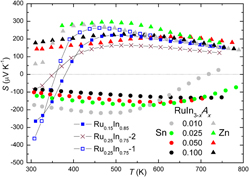Crossref Citations
This article has been cited by the following publications. This list is generated based on data provided by
Crossref.
Kasinathan, Deepa
Wagner, Maik
Koepernik, Klaus
Cardoso-Gil, Raul
Grin, Yu.
and
Rosner, Helge
2012.
Electronic and thermoelectric properties of RuIn3−xAx(A=Sn,Zn).
Physical Review B,
Vol. 85,
Issue. 3,
Verchenko, V.Yu.
Likhanov, M.S.
Kirsanova, M.A.
Gippius, A.A
Tkachev, A.V.
Gervits, N.E.
Galeeva, A.V.
Büttgen, N.
Krätschmer, W.
Lue, C.S.
Okhotnikov, K.S.
and
Shevelkov, A.V.
2012.
Intermetallic solid solution Fe1−xCoxGa3: Synthesis, structure, NQR study and electronic band structure calculations.
Journal of Solid State Chemistry,
Vol. 194,
Issue. ,
p.
361.
Takagiwa, Y.
Kitahara, K.
Matsubayashi, Y.
and
Kimura, K.
2012.
Thermoelectric properties of FeGa3-type narrow-bandgap intermetallic compounds Ru(Ga,In)3: Experimental and calculational studies.
Journal of Applied Physics,
Vol. 111,
Issue. 12,
Takagiwa, Y.
Kitahara, K.
and
Kimura, K.
2013.
Effect of electron doping on thermoelectric properties for narrow-bandgap intermetallic compound RuGa2.
Journal of Applied Physics,
Vol. 113,
Issue. 2,
Takagiwa, Y.
Kitahara, K.
and
Kimura, K.
2013.
Effects of Transition Metal (TM: Co, Rh, Ni and Pd) Substitution for Ru on Thermoelectric Properties for Intermetallic Compound RuGa<sub>2</sub>.
MATERIALS TRANSACTIONS,
Vol. 54,
Issue. 6,
p.
953.
Kieslich, Gregor
Birkel, Christina S.
Douglas, Jason E.
Gaultois, Michael
Veremchuk, Igor
Seshadri, Ram
Stucky, Galen D.
Grin, Yuri
and
Tremel, Wolfgang
2013.
SPS-assisted preparation of the Magnéli phase WO2.90 for thermoelectric applications.
Journal of Materials Chemistry A,
Vol. 1,
Issue. 42,
p.
13050.
Haldolaarachchige, N.
Phelan, W. A.
Xiong, Y. M.
Jin, R.
Chan, J. Y.
Stadler, S.
and
Young, D. P.
2013.
Thermoelectric properties of intermetallic semiconducting RuIn3 and metallic IrIn3.
Journal of Applied Physics,
Vol. 113,
Issue. 8,
Wagner-Reetz, M.
Cardoso-Gil, R.
and
Grin, Yu.
2014.
Substitution Solid Solutions FeGa3−x E x and Their Thermoelectric Properties.
Journal of Electronic Materials,
Vol. 43,
Issue. 6,
p.
1857.
Wagner-Reetz, Maik
Cardoso-Gil, Raul
Schmidt, Marcus
and
Grin, Yuri
2014.
Influence of oxide impurities on the chemical tuning of the thermoelectric properties of substitution derivatives of RuIn3.
Journal of Solid State Chemistry,
Vol. 215,
Issue. ,
p.
260.
Takagiwa, Y.
Matsuura, Y.
and
Kimura, K.
2014.
Effect of Carrier-Doping on the Thermoelectric Properties of Narrow-Bandgap (Fe,Ru)Ga3 Intermetallic Compounds.
Journal of Electronic Materials,
Vol. 43,
Issue. 6,
p.
2206.
Wagner-Reetz, Maik
Kasinathan, Deepa
Schnelle, Walter
Cardoso-Gil, Raul
Rosner, Helge
Grin, Yuri
and
Gille, Peter
2014.
Phonon-drag effect inFeGa3.
Physical Review B,
Vol. 90,
Issue. 19,
Ramachandran, B.
Syu, K.Z.
Kuo, Y.K.
Gippius, A.A.
Shevelkov, A.V.
Verchenko, V.Yu.
and
Lue, C.S.
2014.
Thermoelectric performance of intermetallic FeGa3 with Co doping.
Journal of Alloys and Compounds,
Vol. 608,
Issue. ,
p.
229.
Wagner-Reetz, M.
Cardoso-Gil, R.
Prots, Yu.
Schnelle, W.
and
Grin, Yu.
2014.
Thermoelectric properties of single- and polycrystalline RuGa3.
Solid State Sciences,
Vol. 32,
Issue. ,
p.
56.
Takagiwa, Y.
Utada, S.
Kanazawa, I.
and
Kimura, K.
2015.
MoSi2-type narrow band gap intermetallic compound Al6Re5Si4 as a thermoelectric material.
Journal of Materials Chemistry C,
Vol. 3,
Issue. 40,
p.
10422.
Likhanov, Maxim S.
Verchenko, Valeriy Yu.
Bykov, Mikhail A.
Tsirlin, Alexander A.
Gippius, Andrei A.
Berthebaud, David
Maignan, Antoine
and
Shevelkov, Andrei V.
2016.
Crystal growth, electronic structure, and properties of Ni-substituted FeGa.
Journal of Solid State Chemistry,
Vol. 236,
Issue. ,
p.
166.
Boucher, Benoît
Al Rahal Al Orabi, Rabih
Fontaine, Bruno
Grin, Yuri
Gautier, Régis
and
Halet, Jean-François
2017.
Enhancement of the Thermoelectric Properties of FeGa3-type Structures with Group 6 Transition Metals: A Computational Exploration.
Inorganic Chemistry,
Vol. 56,
Issue. 7,
p.
4229.
Carnicom, E.M.
Xie, W.W.
Seibel, E.M.
Klimczuk, T.
and
Cava, R.J.
2017.
The LaPdIn4 indide and elementary properties of the LaTIn4 (T = Ni, Pd, Pt) materials family.
Journal of Alloys and Compounds,
Vol. 694,
Issue. ,
p.
682.
Berry, T.
Ouardi, S.
Fecher, G. H.
Balke, B.
Kreiner, G.
Auffermann, G.
Schnelle, W.
and
Felser, C.
2017.
Improving thermoelectric performance of TiNiSn by mixing MnNiSb in the half-Heusler structure.
Physical Chemistry Chemical Physics,
Vol. 19,
Issue. 2,
p.
1543.
Verchenko, Valeriy Yu.
Wei, Zheng
Tsirlin, Alexander A.
Callaert, Carolien
Jesche, Anton
Hadermann, Joke
Dikarev, Evgeny V.
and
Shevelkov, Andrei V.
2017.
Crystal Growth of the Nowotny Chimney Ladder Phase Fe2Ge3: Exploring New Fe-Based Narrow-Gap Semiconductor with Promising Thermoelectric Performance.
Chemistry of Materials,
Vol. 29,
Issue. 23,
p.
9954.
Likhanov, M.S.
Verchenko, V.Yu.
Nasonova, D.I.
Gippius, A.A.
Zhurenko, S.V.
Demikhov, E.I.
Kuo, C.N.
Lue, C.S.
Young, B.L.
and
Shevelkov, A.V.
2018.
Crystal structure and magnetic properties of intermetallic semiconductor FeGa3 lightly doped by Co and Ni.
Journal of Alloys and Compounds,
Vol. 745,
Issue. ,
p.
341.





